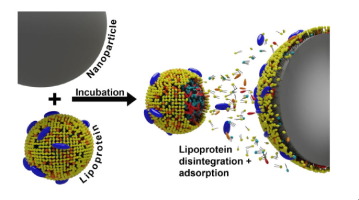Acta Biomaterialia ( IF 9.4 ) Pub Date : 2018-03-07 , DOI: 10.1016/j.actbio.2018.02.036 Julius Müller , Domenik Prozeller , Artur Ghazaryan , Maria Kokkinopoulou , Volker Mailänder , Svenja Morsbach , Katharina Landfester

|
The interaction of nanocarriers with blood plasma components influences the biological response, and therefore, it needs to be controlled. Whereas protein adsorption to nanocarriers has been investigated to a large extent, the role of lipid interaction for drug delivery and its biological effect is not yet clear. However, lipids represent an important constituent of blood plasma and are usually bound in the form of lipoproteins. Because already for many nanocarrier systems an enrichment of apolipoproteins in their protein corona was reported, we examine the interaction of lipoproteins with nanocarriers. If interaction occurs in terms of lipoprotein adsorption, two scenarios are possible: adsorption of intact lipoprotein complexes or disintegration of the complexes with adsorption of the single components. To investigate the interaction and clarify which scenario occurs, polymeric model nanoparticles and different lipoprotein types have been studied by isothermal titration calorimetry, transmission electron microscopy, and other methods. Our data indicate that upon contact with polymeric nanoparticles, disintegration of lipoproteins and adsorption of lipids occurs. Further, the effect of lipoprotein adsorption on cell uptake has been examined, and a major effect of the lipoproteins has been found.
Statement of Significance
It is now well accepted that nanomaterials developed as diagnostic or therapeutic carrier systems need to be well characterized in terms of biological responses inside an organism. Many studies have already shown that proteins adsorb to the surface of a nanomaterial and create a new interface that define the identity of the material. However, the presence of other surface-active components of the blood plasma and how they interact with nanomaterials has been much less investigated. Thus, this study aims at providing a significant contribution to understanding the interaction mechanism between lipoproteins and nanomaterials. Since lipoproteins transport a high amount of lipids, which are surface-active molecules, the demonstrated interactions can go as far as complete lipoprotein disintegration.
中文翻译:

超越蛋白质电晕–脂质对纳米载体生物学反应的重要性
纳米载体与血浆成分的相互作用影响生物反应,因此需要对其进行控制。尽管已经大量研究了蛋白质对纳米载体的吸附,但是脂质相互作用在药物递送中的作用及其生物学作用尚不清楚。但是,脂质代表血浆的重要组成部分,通常以脂蛋白的形式结合。因为已经报道了许多纳米载体系统中载脂蛋白在其蛋白质电晕中的富集,所以我们研究了脂蛋白与纳米载体的相互作用。如果在脂蛋白吸附方面发生相互作用,则可能出现两种情况:完整脂蛋白复合物的吸附或复合物的分解与单个成分的吸附。为研究相互作用并阐明发生哪种情况,已通过等温滴定热分析,透射电子显微镜和其他方法研究了聚合物模型纳米颗粒和不同类型的脂蛋白。我们的数据表明,与聚合物纳米颗粒接触后,会发生脂蛋白的分解和脂质的吸附。此外,已经研究了脂蛋白吸附对细胞摄取的影响,并且发现了脂蛋白的主要作用。
重要声明
现在已经被广泛接受,需要根据生物体内的生物反应对作为诊断或治疗载体系统开发的纳米材料进行良好的表征。许多研究已经表明,蛋白质会吸附到纳米材料的表面,并创建一个定义材料身份的新界面。但是,血浆中其他表面活性成分的存在以及它们与纳米材料的相互作用方式的研究很少。因此,本研究旨在为理解脂蛋白与纳米材料之间的相互作用机制做出重大贡献。由于脂蛋白运输大量的脂质,这些脂质是表面活性分子,因此已证明的相互作用可以使脂蛋白完全分解。











































 京公网安备 11010802027423号
京公网安备 11010802027423号